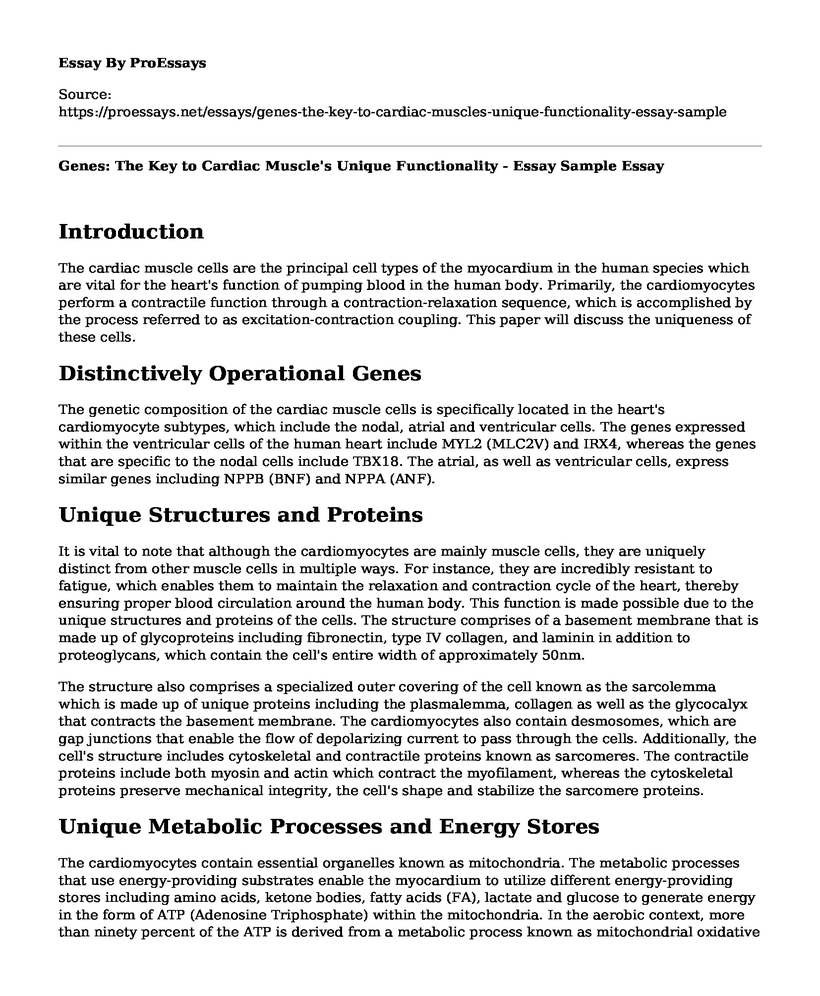Introduction
The cardiac muscle cells are the principal cell types of the myocardium in the human species which are vital for the heart's function of pumping blood in the human body. Primarily, the cardiomyocytes perform a contractile function through a contraction-relaxation sequence, which is accomplished by the process referred to as excitation-contraction coupling. This paper will discuss the uniqueness of these cells.
Distinctively Operational Genes
The genetic composition of the cardiac muscle cells is specifically located in the heart's cardiomyocyte subtypes, which include the nodal, atrial and ventricular cells. The genes expressed within the ventricular cells of the human heart include MYL2 (MLC2V) and IRX4, whereas the genes that are specific to the nodal cells include TBX18. The atrial, as well as ventricular cells, express similar genes including NPPB (BNF) and NPPA (ANF).
Unique Structures and Proteins
It is vital to note that although the cardiomyocytes are mainly muscle cells, they are uniquely distinct from other muscle cells in multiple ways. For instance, they are incredibly resistant to fatigue, which enables them to maintain the relaxation and contraction cycle of the heart, thereby ensuring proper blood circulation around the human body. This function is made possible due to the unique structures and proteins of the cells. The structure comprises of a basement membrane that is made up of glycoproteins including fibronectin, type IV collagen, and laminin in addition to proteoglycans, which contain the cell's entire width of approximately 50nm.
The structure also comprises a specialized outer covering of the cell known as the sarcolemma which is made up of unique proteins including the plasmalemma, collagen as well as the glycocalyx that contracts the basement membrane. The cardiomyocytes also contain desmosomes, which are gap junctions that enable the flow of depolarizing current to pass through the cells. Additionally, the cell's structure includes cytoskeletal and contractile proteins known as sarcomeres. The contractile proteins include both myosin and actin which contract the myofilament, whereas the cytoskeletal proteins preserve mechanical integrity, the cell's shape and stabilize the sarcomere proteins.
Unique Metabolic Processes and Energy Stores
The cardiomyocytes contain essential organelles known as mitochondria. The metabolic processes that use energy-providing substrates enable the myocardium to utilize different energy-providing stores including amino acids, ketone bodies, fatty acids (FA), lactate and glucose to generate energy in the form of ATP (Adenosine Triphosphate) within the mitochondria. In the aerobic context, more than ninety percent of the ATP is derived from a metabolic process known as mitochondrial oxidative phosphorylation (MOP). The rest of the energy production takes place through a metabolic process known as substrate-level phosphorylation which does not need oxygen.
Secretory Products
The products that are secreted from the cardiac muscle cells comprise of BNP (Brain Natriuretic Peptide) as well as ANP (Atrial Natriuretic Peptide). These products have essential antihypertensive, diuretic and vasodilatory effects on the human body. Additionally, a product known as LPL (Lipoprotein Lipase) is manufactured in the cardiomyocytes and secreted into the lumen where it primarily hydrolyses lipoprotein triglycerides resulting in free fatty acids used for energy for consumption.
Signalling of Cell Membrane-Ligand Receptors
Several receptor systems exist on the cell membrane-ligands of the cardiomyocytes, including endothelin, muscarinic, and alpha receptors. These receptors are generally known as GPCRs (G Protein-Coupled Receptors). Examples of the GPCRs include AT2R (angiotensin II type 2 receptor), a1AR, ETBR, v3-AR, v1-AR, and AT1R (angiotensin II type 1 receptor). Specifically, the v1-ARs are responsible for the stimulation of adenylyl cyclase enzyme which increases nuclear cAMP. Other receptors including lysophosphatidic acid receptor-1, and endothelin B, receptors modulate Ca2+ channels. of the nucleoplasm.
Conclusion
This paper has evaluated the uniqueness of cardiac muscle cells based on their operational genes, unique structures and proteins, as well as the metabolic processes and energy stores connected to them. Additionally, the essay has described the essential products secreted from the cells in addition to the signalling of the cell membrane-ligand receptors of the cardiomyocytes.
Cite this page
Genes: The Key to Cardiac Muscle's Unique Functionality - Essay Sample. (2023, Feb 26). Retrieved from https://proessays.net/essays/genes-the-key-to-cardiac-muscles-unique-functionality-essay-sample
If you are the original author of this essay and no longer wish to have it published on the ProEssays website, please click below to request its removal:
- Article Review Exmaple. The Hemispheres of the Brain.
- The Kidney Role in Homeostasis - Paper Example
- Essay Sample on Sustainability in Animal Husbandry
- Response to Student Questions on Lung Capacities Paper Example
- Essay Example on the Edward Memorial Zoological Garden: Gorillas Walking Like Men
- Paper Example on Identifying Animals With Animal Microchips: A Guide
- Exploring North Carolina's 'Outer Banks': From Beachfront to Atlantic Graveyard - Essay Sample







